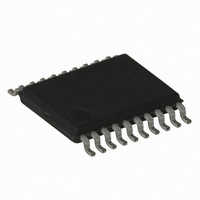AT89LP4052-20XU Atmel, AT89LP4052-20XU Datasheet - Page 36

AT89LP4052-20XU
Manufacturer Part Number
AT89LP4052-20XU
Description
IC 8051 MCU FLASH 4K 20TSSOP
Manufacturer
Atmel
Series
89LPr
Datasheet
1.AT89LP2052-20PU.pdf
(94 pages)
Specifications of AT89LP4052-20XU
Core Processor
8051
Core Size
8-Bit
Speed
20MHz
Connectivity
SPI, UART/USART
Peripherals
Brown-out Detect/Reset, POR, PWM, WDT
Number Of I /o
15
Program Memory Size
4KB (4K x 8)
Program Memory Type
FLASH
Ram Size
256 x 8
Voltage - Supply (vcc/vdd)
2.4 V ~ 5.5 V
Oscillator Type
Internal
Operating Temperature
-40°C ~ 85°C
Package / Case
20-TSSOP
Processor Series
AT89x
Core
8051
Data Bus Width
8 bit
Data Ram Size
256 B
Interface Type
UART, SPI
Maximum Clock Frequency
20 MHz
Number Of Programmable I/os
15
Number Of Timers
2
Operating Supply Voltage
2.4 V to 5.5 V
Maximum Operating Temperature
+ 85 C
Mounting Style
SMD/SMT
3rd Party Development Tools
PK51, CA51, A51, ULINK2
Development Tools By Supplier
AT89ISP
Minimum Operating Temperature
- 40 C
Package
20TSSOP
Device Core
8051
Family Name
AT89
Maximum Speed
20 MHz
Lead Free Status / RoHS Status
Lead free / RoHS Compliant
Eeprom Size
-
Data Converters
-
Lead Free Status / Rohs Status
Details
18.4
36
More About Mode 1
AT89LP2052/LP4052
Ten bits are transmitted (through TXD), or received (through RXD): a start bit (0), 8 data bits
(LSB first), and a stop bit (1). On receive, the stop bit goes into RB8 in SCON. In the
AT89LP2052/LP4052, the baud rate is determined by the Timer 1 overflow rate. The baud rate
is determined by the Timer 1 overflow rate.
the serial port in Mode 1 and associated timings for transmit and receive.
Transmission is initiated by any instruction that uses SBUF as a destination register. The “write
to SBUF” signal also loads a “1” into the ninth bit position of the transmit shift register and flags
the TX Control unit that a transmission is requested. Transmission actually commences at S1P1
of the machine cycle following the next rollover in the divide-by-16 counter. Thus, the bit times
are synchronized to the divide-by-16 counter, not to the “write to SBUF” signal.
The transmission begins when SEND is activated, which puts the start bit at TXD. One bit time
later, DATA is activated, which enables the output bit of the transmit shift register to TXD. The
first shift pulse occurs one bit time after that.
As data bits shift out to the right, “0”s are clocked in from the left. When the MSB of the data byte
is at the output position of the shift register, the “1” that was initially loaded into the ninth position
is just to the left of the MSB, and all positions to the left of that contain “0”s. This condition flags
the TX Control unit to do one last shift, then deactivate SEND and set TI. This occurs at the tenth
divide-by-16 rollover after “write to SBUF.”
Reception is initiated by a 1-to-0 transition detected at RXD. For this purpose, RXD is sampled
at a rate of 16 times the established baud rate. When a transition is detected, the divide-by-16
counter is immediately reset, and 1FFH is written into the input shift register. Resetting the
divide-by-16 counter aligns its roll-overs with the boundaries of the incoming bit times.
The 16 states of the counter divide each bit time into 16ths. At the seventh, eighth, and ninth
counter states of each bit time, the bit detector samples the value of RXD. The value accepted is
the value that was seen in at least 2 of the 3 samples. This is done to reject noise. In order to
reject false bits, if the value accepted during the first bit time is not 0, the receive circuits are
reset and the unit continues looking for another 1-to-0 transition. If the start bit is valid, it is
shifted into the input shift register, and reception of the rest of the frame proceeds.
As data bits come in from the right, “1”s shift out to the left. When the start bit arrives at the left
most position in the shift register, (which is a 9-bit register in Mode 1), it flags the RX Control
block to do one last shift, load SBUF and RB8, and set RI. The signal to load SBUF and RB8
and to set RI is generated if, and only if, the following conditions are met at the time the final shift
pulse is generated.
If either of these two conditions is not met, the received frame is irretrievably lost. If both condi-
tions are met, the stop bit goes into RB8, the 8 data bits go into SBUF, and RI is activated. At
this time, whether or not the above conditions are met, the unit continues looking for a 1-to-0
transition in RXD.
RI = 0 and
Either SM2 = 0, or the received stop bit = 1
Figure 18-2
shows a simplified functional diagram of
3547J–MICRO–10/09












